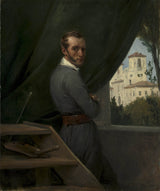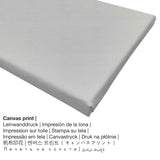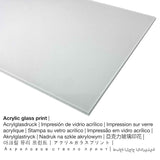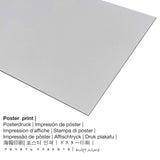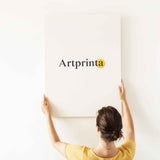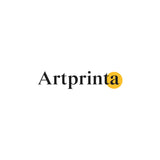Horace Vernet, 1832 - Foto nke onwe na Rome - mbipụta nka mara mma
Ụtụ gụnyere. Mbupu gbakọrọ na ndenye ọpụpụ.
Nkọwa nke ngwaahịa ebipụta
In 1832 Horace Vernet mere 19th narị afọ artwork. The original has the size: Nhazi: 78,5 x 67 x 8 cm (30 7/8 x 26 3/8 x 3 1/8 na); Edebereghị: 65 x 54,2 cm (25 9/16 x 21 5/16 na). Oil on fabric was used by the artist as the medium of the masterpiece. Signed lower right: H Vernet 1832 Rome was the artpiece's original inscription. Nowadays, the work of art is included in the digital collection of The Cleveland Museum of Art. This modern art artwork, which belongs to the ngalaba ọha is supplied with courtesy of The Cleveland Museum of Art. The creditline of the artpiece is: Maazị na Oriakụ William H. Marlatt Fund. E wezụga nke ahụ, nhazi ahụ dị na eserese format with a side ratio of 1 : 1.2, which implies that the length is 20% shorter than the width. Horace Vernet was a male photographer, military personnel, painter, whose art style was primarily Romanticism. The Romanticist painter was born in the year 1789 na Paris, Ile-de-France, France ma nwụọ mgbe ọ dị afọ 74 na 1863.
Họrọ nhọrọ ihe ebipụta nka
Anyị na-enye ụdị dị iche iche nha na ihe maka ngwaahịa ọ bụla. Ị nwere ike ịhọrọ n'ime nhọrọ nhazi ngwaahịa ndị a:
- Mpempe akwụkwọ ederede (akwa akwa akwa): A poster is a UV printed canvas with a slightly roughened texture on the surface. The poster print is used for framing the fine art print with the help of a personal frame. Please bear in mind, that depending on the size of the poster we add a white margin of approximately 2-6cm around the artwork, which facilitates the framing with your custom frame.
- Bipụta na iko acrylic (nke nwere ezigbo mkpuchi iko): A glossy acrylic glass print, often denoted as a print on plexiglass, will transform the original artwork into brilliant home décor. Your own replica of the work of art will be made with the help of modern UV direct print technology. Our plexiglass with real glass coating protects your selected fine art print against light and heat for up to 60 years.
- Mbipụta ọla (aluminium dibbond): Aluminium Dibond prints are metal prints with an impressive effect of depth. A non-reflective surface creates a modern look. The Aluminium Dibond Print is the ideal introduction to replicas with aluminum.
- Mbipụta kanvas: The canvas print, not to be confused with an artwork painted on a canvas, is a digital replica applied on a canvas. Your canvas of your favorite masterpiece will allow you to transform your art print into a large artwork like you would see in a true gallery. Canvas Prints have the advantage of being relatively low in weight, which implies that it is easy to hang up the Canvas print without any wall-mounts. Therefore, a canvas print is suitable for all kinds of walls.
Disclaimer: We try in order to describe the products as accurate as possible and to display them visually in our shop. Although, the pigments of the print materials and the printing might differ slightly from the image on your screen. Depending on your screen settings and the quality of the surface, colors might not be printed 100% realistically. Because the art reproductions are printed and processed by hand, there may also be minor deviations in the motif's exact position and the size.
Nkọwa akụkọ ahaziri ahazi
| Nkewa edemede: | ọmarịcha nka |
| Usoro mmeputakwa: | mmeputakwa n'ụdị dijitalụ |
| Production usoro: | Mbipụta UV ozugbo (mbipụta dijitalụ) |
| Production: | emere na Germany |
| Ụdị ngwaahịa: | mmepụta ihe na-achọ |
| Ojiji ngwaahịa: | ime ụlọ, ihe ndozi mgbidi |
| Ntuziaka onyonyo: | usoro eserese |
| Ụdị anya: | ogologo: obosara - 1: 1.2 |
| Nkọwa: | ogologo bụ 20% mkpụmkpụ karịa obosara |
| Ụdị dị iche iche dị: | Mbipụta iko acrylic (nke nwere ezigbo mkpuchi iko), mbipụta kanvas, mbipụta ọla (aluminium dibond), mbipụta akwụkwọ mmado (akwụkwọ kwaaji) |
| Mbipụta kanvas (akwa akwa n'elu etiti ihe ndọtị) ụdị nha dị iche iche: | 50x60cm - 20x24", 100x120cm - 39x47", 150x180cm - 59x71" |
| Acrylic glass print (nwere ezigbo mkpuchi iko) nhọrọ: | 50x60cm - 20x24", 100x120cm - 39x47", 150x180cm - 59x71" |
| Mbipụta akwụkwọ mmado (akwụkwọ kwaaji): | 50x60cm - 20x24", 100x120cm - 39x47" |
| Aluminium dibond ebipụta (ihe aluminium) dị iche iche: | 50x60cm - 20x24", 100x120cm - 39x47" |
| Igwe onyonyo: | agunyeghi |
Iberibe nkọwa nka
| Aha eserese: | "Self-Portrait in Rome" |
| nhazi ọkwa: | sere |
| Okwu nche anwụ: | nkà nke oge a |
| Narị afọ nka: | 19th narị afọ |
| Afọ okike: | 1832 |
| Ogologo afọ nka nka: | karịa afọ 180 |
| Usoro nka izizi: | mmanụ na akwa ákwà |
| Nha izizi (ọrụ nka): | Nhazi: 78,5 x 67 x 8 cm (30 7/8 x 26 3/8 x 3 1/8 na); Edebereghị: 65 x 54,2 cm (25 9/16 x 21 5/16 na) |
| mbinye aka izizi nka: | signed lower right: H Vernet 1832 Rome |
| Ụlọ ihe ngosi nka / mkpokọta: | Velọ ihe ngosi nka nke Cleveland |
| Ebe ngosi nka: | Cleveland, Ohio, United States nke America |
| website: | Velọ ihe ngosi nka nke Cleveland |
| Licensedị ikike: | ngalaba ọha |
| Site n'aka: | Velọ ihe ngosi nka nke Cleveland |
| Ebe E Si Nweta: | Maazị na Oriakụ William H. Marlatt Fund |
Tebụl onye na-ese ihe
| aha: | Horace Vernet |
| Aha ndị ọzọ: | Horace Vernet, emil jean horace vernet, e. j. horace vernet, Vernet Horace, ורנה אמיל ז'אן הוראס, M. Verne, E. J. H. Vernet, Vernet Hor., Vernet, Vernet fils, vernet horace, Emile Jean Horace Vernet, H. Vernet, Vernet Emile Jean Horace, Vernet Emile-Jean-Horace |
| okike nke onye nka: | nwoke |
| Nationality: | French |
| Ọrụ: | onye na-ese ihe, onye na-ese foto, ndị agha |
| Mba onye si: | France |
| Nhazi nke onye nka: | omenkà nke oge a |
| Ụdị nka: | Ihunanya |
| Nwụrụ anwụ: | 74 afọ |
| Amụrụ n'afọ: | 1789 |
| Ebe omuma: | Paris, Ile-de-France, France |
| Nwụrụ n'afọ: | 1863 |
| Obodo ọnwụ: | Paris, Ile-de-France, France |
© nwebiisinka site na - Artprinta.com
Nkọwa ihe osise izizi sitere na webụsaịtị ihe ngosi nka (© - site na Cleveland Museum of Art - www.clevelandart.org)
Vernet stands before the Villa Medici, seat of the French Academy in Rome, where he was director from 1829 to 1835. The palette, brushes, and maulstick on the stepladder hint at his talent for painting large canvases. The artist's sideward glance, disheveled hair, and burning cigarette lend him a romantic aura. The recipient of numerous commissions for military paintings, Vernet was patronized by Jérôme Bonaparte (the youngest brother of Napoleon) and later taught at the École des Beaux-Arts.

